Trango Systems M5830SSU 5Ghz Wireless Internet Access Point Subscriber Uni User Manual P5830 Manual rev A
Trango Systems Inc 5Ghz Wireless Internet Access Point Subscriber Uni P5830 Manual rev A
Contents
User Manual for Class I Permissive Change
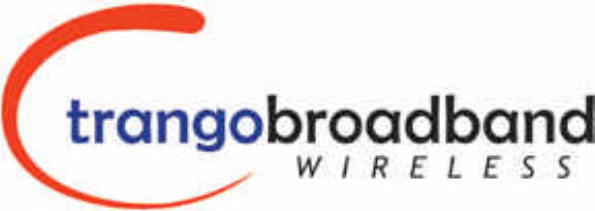
TrangoLINK-10
Point to Point
Wireless Ethernet Bridge
USER MANUAL
June 11, 2003
-DRAFT-
Rev. A for Firmware ver. 1.0

Table of Contents Trango
Trango Broadband Wireless — TrangoLINK User Manual Rev. A for Firmware Ver. 1.0 page ii
Table of Contents
Preface.................................................................................................................................................................. iii
FCC Information............................................................................................................................................... iii
Warranty Information....................................................................................................................................... iii
Chapter 1 Welcome!....................................................................................................................................... 1
Getting to Know Your Radio............................................................................................................................. 1
Contents......................................................................................................................................................... 1
Ethernet and Serial Ports ............................................................................................................................... 2
Antennas........................................................................................................................................................ 2
MU/RU Operational Overview.......................................................................................................................... 2
Chapter 2 Getting Started............................................................................................................................... 3
Connections and Power ..................................................................................................................................... 3
Basic Configuration - Concepts and Tools........................................................................................................ 4
Opmode Concept........................................................................................................................................... 4
Command Line Interface ............................................................................................................................... 4
Browser Interface .......................................................................................................................................... 5
Master Unit Basic System Information ............................................................................................................. 7
Remote Unit Basic System Information ............................................................................................................ 9
Chapter 3 Establishing a Wireless Link ....................................................................................................... 10
Procedure to Establish Wireless Link.............................................................................................................. 10
Master Unit.................................................................................................................................................. 10
Association Concept (MU to RU communications) .................................................................................... 11
Basic Diagnostics ............................................................................................................................................ 11
Chapter 4 Deployment.................................................................................................................................. 13
Site Selection................................................................................................................................................... 13
Site survey ....................................................................................................................................................... 13
Channel Planning............................................................................................................................................. 14
Installation ....................................................................................................................................................... 14
Mounting Hardware..................................................................................................................................... 14
Cabling and Weather Considerations .......................................................................................................... 16
RU Installation and Antenna Alignment.......................................................................................................... 17
RU Antenna Alignment Procedure.............................................................................................................. 17
Link Test.......................................................................................................................................................... 17
Chapter 5 Management ................................................................................................................................ 18
MU-Centric RU Management ......................................................................................................................... 18
Managing MU from RU side of Network.................................................................................................... 18
SNMP .............................................................................................................................................................. 18
Objects for Monitoring and Control ............................................................................................................ 18
SNMP Setup ................................................................................................................................................ 19
Command Set Summary...................................................................................................................................... 21
Chapter 6 Specifications............................................................................................................................... 24
Chapter 7 Glossary....................................................................................................................................... 25
Table of Figures
Figure 0-1 Components of an TrangoLINK System.............................................................................................. 1
Figure 0-2 Back of Radio Showing where MAC address can be Found ............................................................... 2
Figure 0-3 Wiring Diagram ................................................................................................................................... 3
Figure 0-4 How Opmode Effects Management..................................................................................................... 4
Figure 0-5 Reference Table of Basic MU System Information............................................................................. 8
Figure 0-6 Reference Table of Basic RU System Information.............................................................................. 9
Figure 0-7 Default Channel Table (MHz) ........................................................................................................... 14
Figure 0-8 Mounting Hardware Assembly.......................................................................................................... 15
Figure 0-9 Mounting Options.............................................................................................................................. 16
Figure 0-10 Grounding Example......................................................................................................................... 16

Command Set Summary FCC Information
Trango Broadband Wireless — TrangoLINK User Manual Rev. A for F/W Ver. 1.0 page iii
Preface
This manual covers basic configuration and installation of the TrangoLINK-10 Wireless Broadband System and applies
to the following radio part numbers:
P5830S-MU Master Unit with internal sector al patch antenna
P5830S-RU Remote Unit with internal patch antenna
Also available is the TrangoLINK-10-EXT, which does not include an internal antenna. The TrangoLINK-10-EXT
which consists of a P5830S-MU-EXT and a P5830S-RU-EXT, must be used in conjunction with an FCC certified
external antenna (sold separately). Instead of an internal antenna, the P5830S-RU-EXT has two Reverse Polarity SMA
RF Connectors for attachment of external antenna cables. The installation of the P5830S-RU-EXT requires professional
installation due to FCC limits on output power settings when using the 5.3 GHz U-NII band. Contact your sales person
for more information regarding “Professional Installation Guide.”
FCC Information
This device complies with Part 15 of FCC Rules and Regulations. Operation is subject to the following two conditions:
(1) This device may not cause harmful interference and (2) this device must accept any interference received, including
interference that may cause undesired operation.
This equipment has been tested and found to comply with the limits for a Class B digital device, pursuant to Part 15 of the
FCC Rules. These limits are designed to provide reasonable protection against harmful interference in a residential
installation. This equipment generates, uses, and can radiate radio-frequency energy and, if not installed and used in
accordance with these instructions, may cause harmful interference to radio communications. However, there is no
guarantee that interference will not occur in any particular installation. If this equipment does cause harmful interference
to radio or television reception, which can be determined by turning the equipment off and on, the user is encouraged to
correct the interference by one of more of the following measures:
1) Reorient the antenna;
2) Increase the separation between the affected equipment and the unit;
3) Connect the affected equipment to a power outlet on a different circuit from that which the receiver is connected to;
4) Consult the dealer and/or experienced radio/TV technician for help.
FCC ID: NCYM5830SSU
FCC ID: NCYM5830SSUEXT
IMPORTANT NOTE:
Intentional or unintentional changes or modifications must not be made unless under the express consent of the party
responsible for compliance. Any such modifications could void the user’s authority to operate the equipment and will
void the manufacturer’s warranty. To comply with FCC RF exposure requirements, the following antenna installation and
device operating configurations must be satisfied. The antenna for this unit must be fixed and mounted on outdoor
permanent structures with a separation distance of at least two meters from all persons. Furthermore, it must not be co-
located or operating in conjunction with any other antenna or transmitter.
Warranty Information
Radios from Trango Broadband Wireless are warranted for one year from date of purchase. Please see
www.trangobroadband.com for complete description of warranty coverage and limitations.

Command Set Summary Getting to Know Your Radio
Trango Broadband Wireless — User Manual TrangoLINK Rev. A for F/W Ver. 1.0 Page 1
Chapter 1 Welcome!
Your TrangoLINK-10 radio system provides the latest innovations in high speed fixed wireless broadband.
TrangoLINK -10 is a point-to-point (PtP) system which provides network connectivity at speeds up to 10 Mbps with a
range of 40 miles depending on antenna configuration. TrangoLINK-10 is unique in that it can operate in either the 5.8
GHz ISM band or the 5.3 GHz U-NII band. In this document and within the radio configuration itself, the designators of
“ISM” and “U-NII” are used to distinguish between the two bands.
The following table shows approximate maximum ranges (at recommended fade margins) achievable with the
TrangoLINK-10 system using various antenna configurations. Longer ranges are achievable, but will result in
lower fade margins.
TrangoLINK-10 system consists of two types of radios: Master Units (MU) and Remote Units (RU). With careful
channel planning, (and adequate spacing and shielding) network operators can co-locate up to 22 MUs at a single cell
site.
The MU and RU conform to maximum radiated power limits as established by the FCC.
Getting to Know Your Radio
Contents
Each TrangoLINK-10 kit comes equipped with two radios, two power-over-Ethernet (PoE) J-Box, two AC adapters, a
serial programming cable, and mounting hardware. Dual-polarized internal antennas are included within the Radomes of
both the M5830S-MU and M5830S-RU.
Figure 0-1 Components of an TrangoLINK System
Antenna ISM 5725 – 5850 MHz U-NII 5250 – 5350 MHz
Integrated / Internal Antenna (18 dBi) 10 Miles (w/ 10 dB fade margin) 3 Miles (w/ 10 dB fade margin)
18" Dish Antenna (24 dBi) 20 Miles (w/15 dB fade margin) 5 Miles (w/ 10 dB fade margin)
15" Patch Antenna (24 dBi) 20 Miles (w/15 dB fade margin) 5 Miles (w/ 10 dB fade margin)
36" Dish Antenna (31 dBi)
40 Miles (w/21 dB fade margin) 10 Miles (w/ 10 dB fade margin)
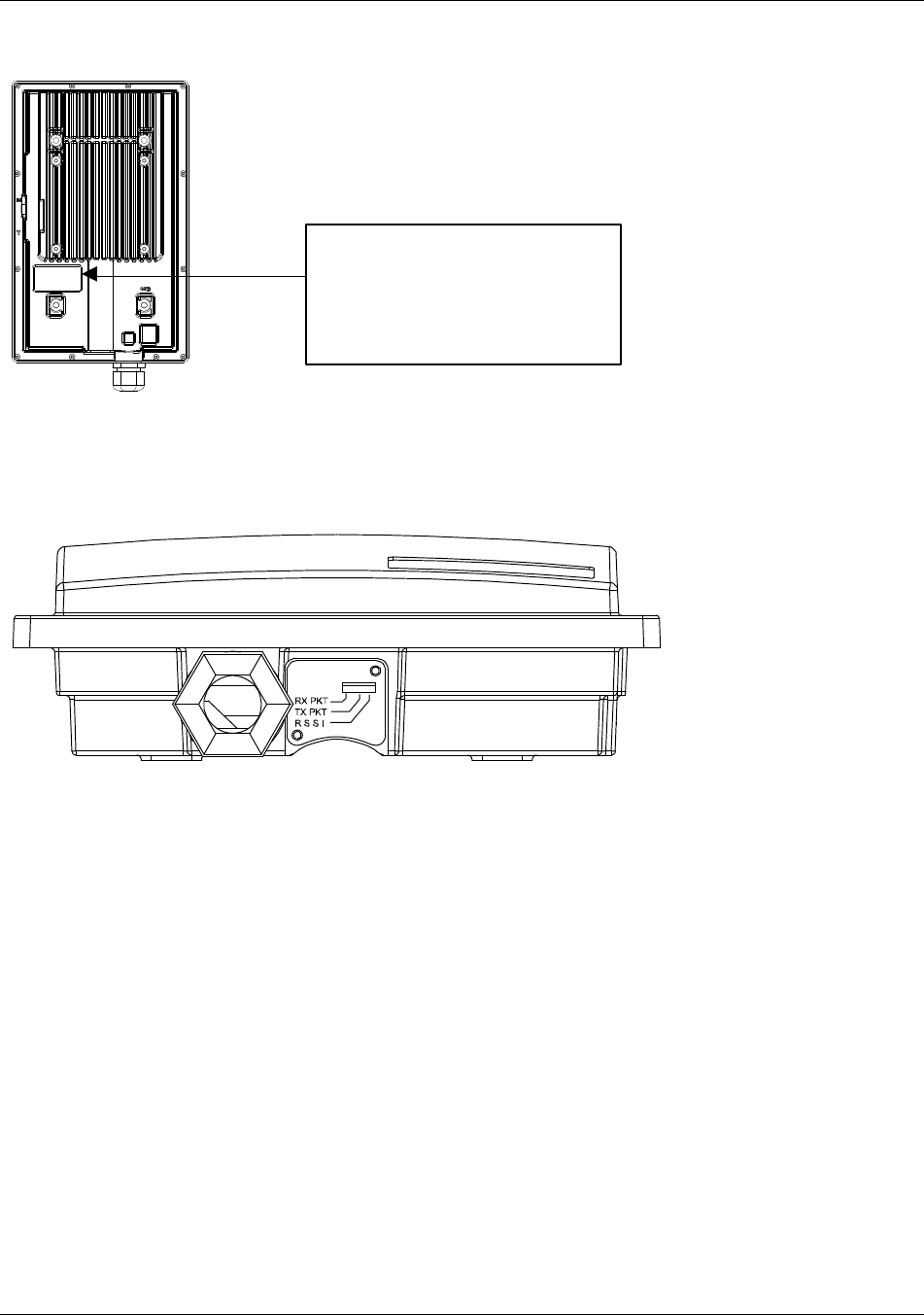
Command Set Summary MU/RU Operational Overview
Trango Broadband Wireless — User Manual TrangoLINK Rev. A for F/W Ver. 1.0 Page 2
Figure 0-2 Back of Radio Showing where MAC address can be Found
Ethernet and Serial Ports
At the bottom of the radio are two access ports: a twist-on weatherproof cable port for RJ-45 Ethernet (and PoE), and an
access cover (with two screws) for RJ-11 serial port. Most configuration and management tasks can be performed
through the Ethernet jack. The access cover also contains a small window which reveals three LEDs. These LEDs
provide RF link-status information. These LEDs will be discussed later in this text.
Antennas
The M5830S-MU and M5830S-RU each include dual polarized antennas. The M5830S-MU-EXT and M5830S-RU-EXT
are designed to work with FCC certified external patch style or dish antennas. All of these antennas can be
electronically switched between horizontal (H) and vertical (V) polarization.
MU/RU Operational Overview
TrangoLINK MU is a sophisticated broadband wireless device which provides a host of comprehensive tools and
functions. The MU typically resides at the managing end of the network and performs all management functions for the
associated RU.
In order to make a link more secure, prior to an RU communicating with a MU, the system administrator must
first add the MAC address and ID number of the RU to the user database in the MU.
When power is first applied to a properly installed RU, it will scan all the channels in its Scantable, searching
for an MU. The RU will then stop on that channel and respond to the MU using maximum RF power. Before
the MU can wirelessly connect to the RU, it must authenticate the RU by verifying the MAC address, and
performing a ranging operation to the RU.
Upon successfully locating and ranging the RU, the MU will adjust the RF transmit power in the RU based on
the Target RSSI parameter in the MU. This process is referred to as “power leveling”.
MUs and RUs look identical. The only way to tell
them apart is by the model number printed on the
backside product label. This label also contains
the MAC ID of the radio as well as the serial #.
Trango Broadband Wireless
P5830S-MU Rev. A
S/N: 000001421
MAC: 00 01 DE 00 02 F3
FCC ID: NCYM5830SM
Canada: XXXXXXXXXX
This equipment has been tested and found to comply with the limits for a Class B
digital device, pursuant to Part 15 of the FCC Rules. These limits are
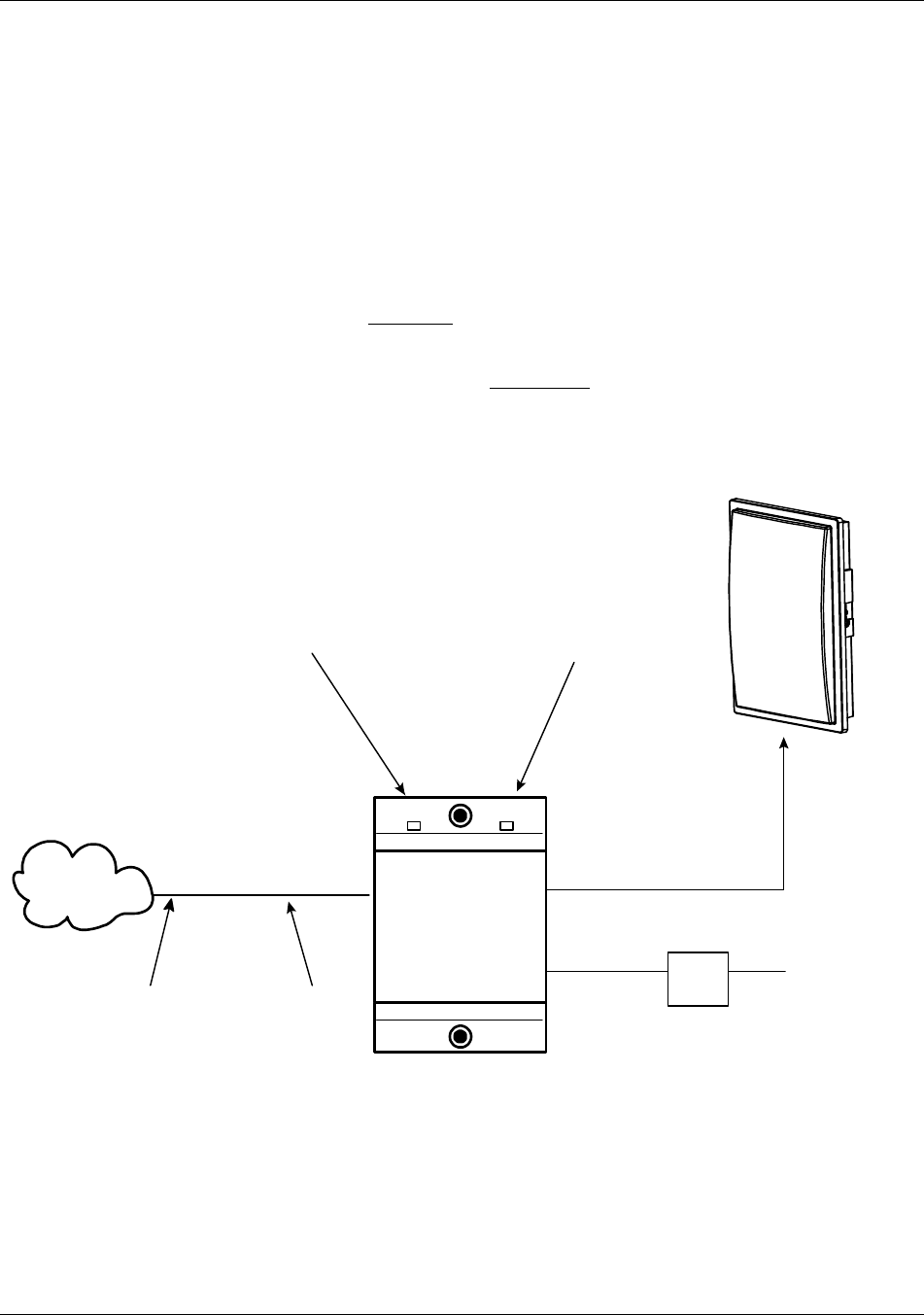
Command Set Summary Connections and Power
Trango Broadband Wireless — User Manual TrangoLINK Rev. A for F/W Ver. 1.0 Page 3
Chapter 2 Getting Started
First unpack your MU and RU. It is recommended to first provision and test the radios on the bench before deploying in
the field. This is a particularly useful exercise to the novice user.
Connections and Power
Connection and powering of radios is the same for MUs and RUs.
?? Connect a Cat-5 (straight through) Ethernet cable (we recommend shielded twisted pair) between the ODU (out
door unit) port of the J-box and the RJ-45 connector on the radio. Note that this cable will carry power over
Ethernet (PoE).
?? If connecting to a COMPUTER, use a Cross-Over Ethernet cable from the NET port of the J-box to the
computer’s Ethernet port.
If connecting to a HUB, SWITCH, or ROUTER, use a Straight-Thru cable.
?? Plug the AC adapter into an AC outlet.
Figure 0-3 Wiring Diagram
POWER ODU
POWER
ODUNET
LED Indicates
power to J-Box LED Indicates
power to Radio
Master Unit or Remote Unit
AC Power
CAT-5
Straight-Thru
Cable
20 V
Power
Supply
Network
or
PC
CAT-5
Use cross-over
cable if to PC
Power over Ethernet
J-Box
Use straight-thru cable
if to hub, switch
or router
Both green LEDs on the J-box should be lit, indicating power is present at the J-box as well as the radio.
You are now ready to configure the radio via the Ethernet port.
? Note: If you can not access the radio management functions via the Ethernet port, it is possible that your PC is not
set up with a properly routable subnet. If you forget the radio’s IP address, or for some other reason can not access
the radio via the Ethernet port, use the Serial Programming cable (supplied with each TrangoLINK kit) and attach
to RJ-11 located behind access cover on bottom of radio.
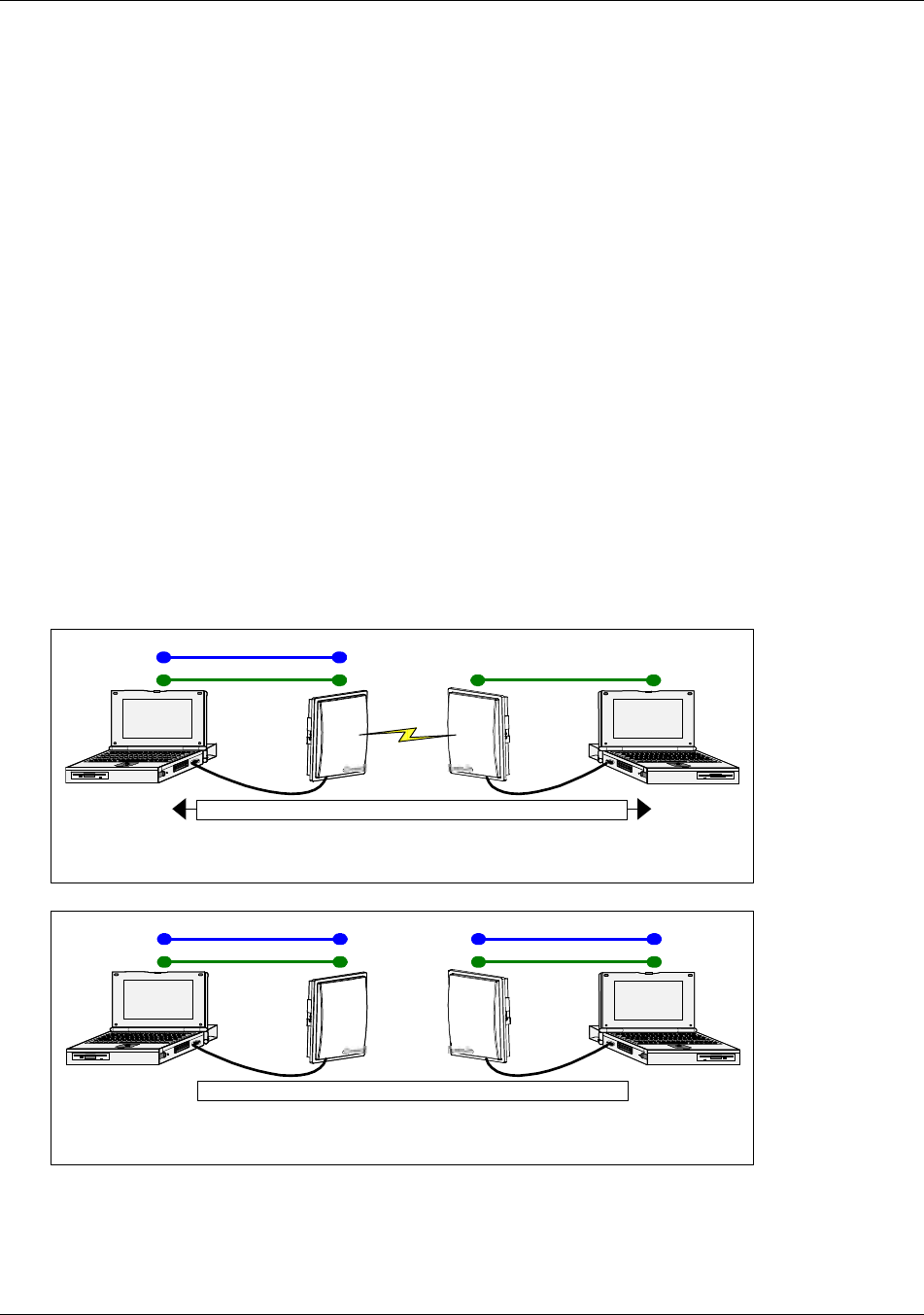
Command Set Summary Basic Configuration - Concepts and Tools
Trango Broadband Wireless — User Manual TrangoLINK Rev. A for F/W Ver. 1.0 Page 4
Basic Configuration - Concepts and Tools
The TrangoLINK-10 can be configured using either the Command Line Interface (CLI) or the Web Browser (HTTP)
interface. Although both methods are comprehensive and powerful, the CLI method provides slightly more functionality.
Both methods of radio configuration require an understanding of the concept of Operation Mode or “Opmode”.
Opmode Concept
Before logging on to a radio, it is important to understand the “opmode” concept of the TrangoLINK system. MUs and
RUs can be in one of two Opmodes; OFF and ON. When in “OFF,” Opmode the radio is not transmitting, and it is not
attempting to make a wireless connection. Alternatively, when in “ON,” opmode the radio is transmitting, and is
attempting to make a wireless connection.
Why is Opmode Important?
TCP/IP management access (via the Ethernet port) to a Remote Unit is only possible in opmode “OFF”. However
TCP/IP management of a Master Unit is possible in either opmode, On or Off.
Also, certain functions, such as the site survey function and the RU RSSI function can only be performed while the radio
is in opmode “OFF”. See Appendix – Command Set Reference for a complete listing of commands, and the appropriate
opmode(s) for each command.
? Note: Factory Default opmode for both MUs and RUs is “ON”. Default opmode should be changed before radios
are deployed.
? Note: Serial management (via the RJ-11 port) is possible on both MUs and RUs regardless of opmode.
Figure 0-4 How Opmode Effects Management
Opmode = Off
PC2
MU RU
PC1
No Network Traffic
TCP/IP Mgmt.
Serial Mgmt. Serial Mgmt.
TCP/IP Mgmt.
Opmode = ON
PC2
MU RU
PC1
Network Traffic
TCP/IP Mgmt.
Serial Mgmt. Serial Mgmt.
Command Line Interface
Although most radio functions can be managed via the browser interface, the command line interface (CLI) does provide
slightly more functionality. Logging on to the radio via command line interface is covered here briefly, but for a
complete listing of all CLI commands, see the Appendix - Command Line Interface.

Command Set Summary Basic Configuration - Concepts and Tools
Trango Broadband Wireless — User Manual TrangoLINK Rev. A for F/W Ver. 1.0 Page 5
Telnet
Open a command prompt (DOS) session on your PC. Open a Telnet session by typing
telnet [ip address of radio]
Example:
C:>telnet 192.168.100.100
? Note: All Trango radios (MU and RU) come factory pre-configured with a default IP address 192.168.100.100.
You will be greeted with current hardware and firmware information and prompted for a password. Type in the password
and press enter.
? Note: The factory default password is trango.
? Note: If you can not telnet into the radio, check cable connections, ensure proper use of cross-over vs. straight-
through cable, ensure PC’s subnet is routable to radio’s IP address. To Telnet to an RU, ensure that its opmode is
“off”.
Serial
A Terminal Emulation program (such as HyperTerminal on the Windows operating system) can be used to access the
radio’s CLI via the radio’s serial port which is located behind the RJ-11 access cover on the bottom of the radio. A serial
programming cable has been provided with each MU for this purpose. The same cable may be used for Remote Units.
The terminal program settings are 8-N-1, and Flow control: None.
? Note: To terminate a CLI session (Telnet or Serial) type the command logout.
? Note: Type help, or ? for a listing of all CLI commands. Type help <command> for the syntax of a
particular command.
Browser Interface
The Web browser interface is a powerful and easy-to-use configuration and management tool. Its functionality is a subset
of the commands available in the CLI. To use the browser interface – you must have the following:
?? An Ethernet connection between a PC and the radio
?? Setup your Ethernet PC connection to the subnet that is routable to the radio (default IP
address=192.168.100.100)
?? A web browser (i.e. Microsoft Internet Explorer)
In order to use the browser interface – simply connect the radio to a PC, and type the radio’s IP address into the web
browser (i.e. Microsoft Internet Explorer). This will bring up a logon page.
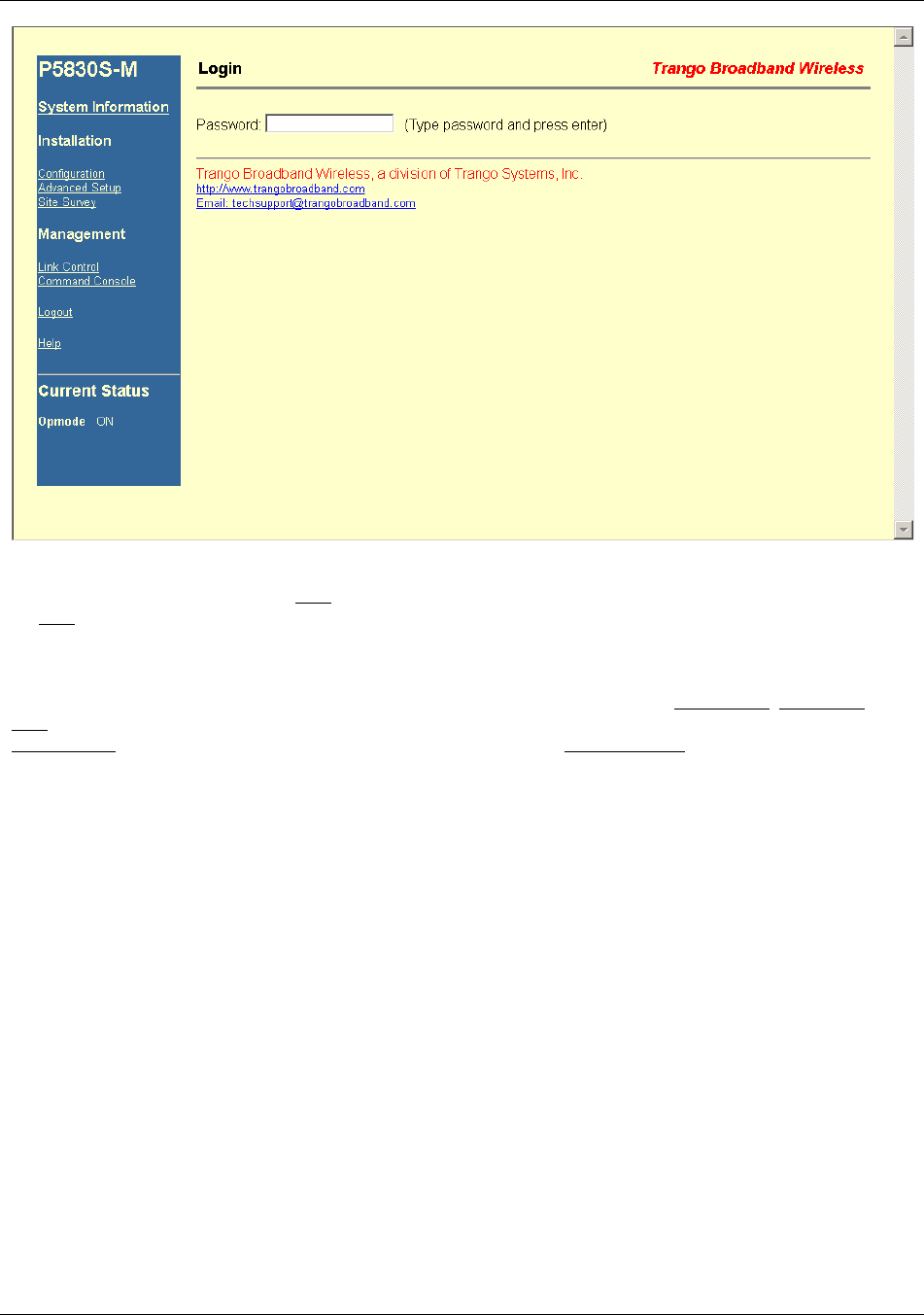
Command Set Summary Basic Configuration - Concepts and Tools
Trango Broadband Wireless — User Manual TrangoLINK Rev. A for F/W Ver. 1.0 Page 6
Type the password (default trango) and continue. This will bring up the radio’s system information page.
The Browser Interface features useful Help pages which explain all listed parameters. To access the help pages click on
the Help link.
This particular Login Page is for Master Unit, which can be seen by the P5830S-M in the top left. The panel on the left is
the same for all Browser pages. All navigation can be performed from this panel. Items in bold, such as Installation,
Management, and Current Status are general headings. The underlined words, such as Link Control, Site Survey, and
Help lead to the other pages in the Browser Interface for the radio. Basic configuration can be performed from the
Configuration page, and RF related parameters are configured through the Advanced Setup page.
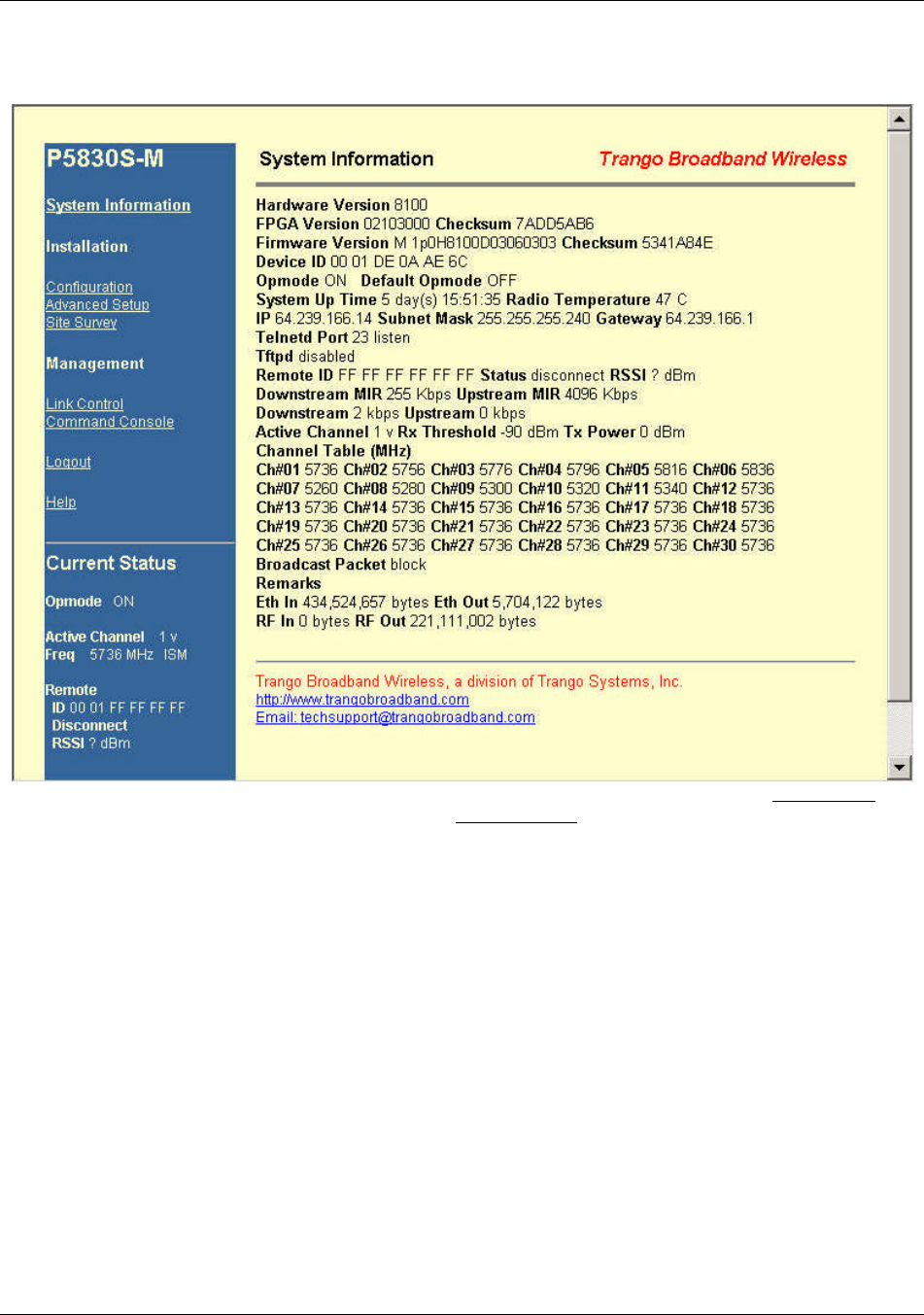
Command Set Summary Master Unit Basic System Information
Trango Broadband Wireless — User Manual TrangoLINK Rev. A for F/W Ver. 1.0 Page 7
Master Unit Basic System Information
Logon to the MU and the System Configuration page with info and status appears. The equivalent command for the CLI
is sysinfo.
Many of these parameters can be changed by the user. Basic configuration can be performed from the Configuration
page, and RF related parameters are configured through the Advanced Setup page.. A description of each of these
changeable parameters, along with the related command for the CLI is shown in the tables below.
? Note: When changing settings, it is usually necessary to click the Save and Activate Button in order to update the
radio’s flash memory. If you do not, the setting will be lost the next time the radio is rebooted.

Command Set Summary Master Unit Basic System Information
Trango Broadband Wireless — User Manual TrangoLINK Rev. A for F/W Ver. 1.0 Page 8
Figure 0-5 Reference Table of Basic MU System Information
MU SYSTEM INFORMATION PARAMETERS AND RELATED COMMANDS
Parameter Description Related CLI Command
Device ID Mac ID of MU N/A
Remote ID Mac ID of the RU that is going to be associated
to the MU. N/A
Opmode Current Opmode of radio opmode <on or off> to change the opmode
from Off to On. Note: in order to change
radio from opmode on to opmode off, you
must change the default opmode to off and
reboot the radio.
Default opmode Determines the opmode (“on” or “off”) of the
radio after reboot/power cycle. When the
parameter is set to “on”, the radio will progress
into “on” opmode automatically after
reboot/power cycle.
set defaultopmode <on or off>
Example:
#>set defaultopmode on
[IP]
[subnet]
[gateway]
IP, subnet, and Gateway address of radio ipconfig [<new ip> <new subnet mask>
<new gateway>]
Example:
#>ipconfig 192.168.100.101
255.255.255.0 192.168.10.10
Tftpd status Tftpd status (on or off). Tftpd should be turned
on to import file into radio (such as new
firmware). Default is off.
tftpd on tftpd off
Active Channel Current RF channel and polarization (v)ertical or
(h)orizontal. freq writescan [<ch#><v|h>]
Example:
#>freq writescan 5 v
This command will change the channel of
the MU to 5, vertical.
RF Rx Threshold Specifies the receiver sensitivity of the MU. It is
a powerful tool when the radio is in a noisy
environment. MU will block out any signal
received which is below the RF Rx threshold.
Separate settings exist for both ISM and UNII
bands.
rfrxth <ism|unii><-90|-85|-80|-75|-70|-65>
examples:
#>rfrxth ism –70
#>rfrxth unii -90
RF Tx Power Current transmit power of the MU not including
antenna gain. power <setism|senunii>
<min|max|<dBm>>
Examples:
#>power setism 10
#>power setunii 4
Channel Table Lists each of the assigned frequencies to each
channel. Note that default channels 1 – 6 are
assigned to ISM band and channels 7 – 11 are
assigned to U-NII band. All channels may be re-
assigned as desired by the user.
freq writechannel [<ch#><freq>]
Example:
#>Freq writechannel 2 5785
This command will change
channel 2 to 5785 Mhz.
Broadcast Packet
Filter This switch (0) enables/disables the blocking of
Ethernet control packet except ICMP and ARP
to reduce the amount of unnecessary overhead
introduced to the wireless link
sw 0 [on|off] (default is on)
(See the Command Set Reference)
Remarks User definable radio information (i.e. customer
name, address of installation, and so on).
Maximum 28 characters can be stored.
remarks [remarks]
Example:
#>remarks 123 Elm Street
? Note: If you make any changes to system settings, don’t forget to click the Save and Activate Button..

Command Set Summary Remote Unit Basic System Information
Trango Broadband Wireless — User Manual TrangoLINK Rev. A for F/W Ver. 1.0 Page 9
Remote Unit Basic System Information
Logon to the RU (while it is in opmode “OFF”) and the System Information page will appear. In the CLI, type the
command sysinfo to receive a comprehensive snapshot of the system’s configuration info and status. Many of these
parameters can be changed by the user. A description of each of these changeable parameters, along with the related
command is shown in the table below.
? Note: When changing settings, it is usually necessary to click the Save and Activate Button in order to update the
radio’s flash memory. If you do not, the setting will be lost the next time the radio is rebooted.
Figure 0-6 Reference Table of Basic RU System Information
REMOTE SYSTEM INFORMATION PARAMETERS AND RELATED COMMANDS
Parameter Description Related CLI Command
Device ID Mac ID of RU, this is used as the Remote ID
on the MU. N/A
Opmode Current Opmode of radio. opmode <on or off> to change the
opmode from Off to On. Note: in order
to change radio from opmode on to
opmode off, you must change the default
opmode to off and reboot the radio.
Default opmode Determines the opmode (“on” or “off”) of the
radio after reboot/power cycle. When the
parameter is set to “on”, the radio will
progress into “on” opmode automatically after
reboot/power cycle.
set defaultopmode <on or off>
Example:
#>set defaultopmode on
Opmode Start Determines the amount of time the radio will
remain in opmode OFF after reboot before
progressing to the default opmode.
set default opmode <time (secs)>
[IP]
[subnet]
[gateway]
IP, subnet, and Gateway address of radio ipconfig [<new ip> <new subnet mask>
<new gateway>]
Example:
#>ipconfig 192.168.100.101
255.255.255.0 192.168.10.10
Tftpd Tftpd status (on or off). Tftpd should be
turned on to import file into radio (such as
new firmware). Default is off.
tftpd on tftpd off
RF Tx Power Current transmit power of the RU not
including antenna gain. This is controlled
during the association process.
Informational Parameter
Channel Table Lists each of the assigned frequencies to each
channel. freq writechannel [<ch #> freq>]…*
Channel Scan Sequence Shows the various channels (in sequence)
which the RU will scan while search for a
MU.
freq writescan [<ch #> <h|v>…
<ch #>=1..30]
Active Channel Shows the channel used in the current
association. Information Parameter
Broadcast Packet Filter This switch (switch 0) enables/disables the
blocking of Ethernet control packet except
ICMP and ARP to reduce the amount of
unnecessary overhead introduced to the
wireless link.
sw 0 [on|off] (default is on)
(See the Command Set Reference)
MU Autoscan This switch (switch 1) is to turn MU autoscan
on or off. sw 1 [on|off] (default is on)
(See the Command Set Reference)
TCP/IP for MU This switch (switch 2) when on, allows users
at the MU side of the network to telnet or http
into the RU.
sw 2 [on|off] (default is off)
(See the Command Set Reference)
Remarks User definable radio information (i.e.
customer name, address of installation, and so
on). Maximum 28 characters can be stored.
remarks [remarks]
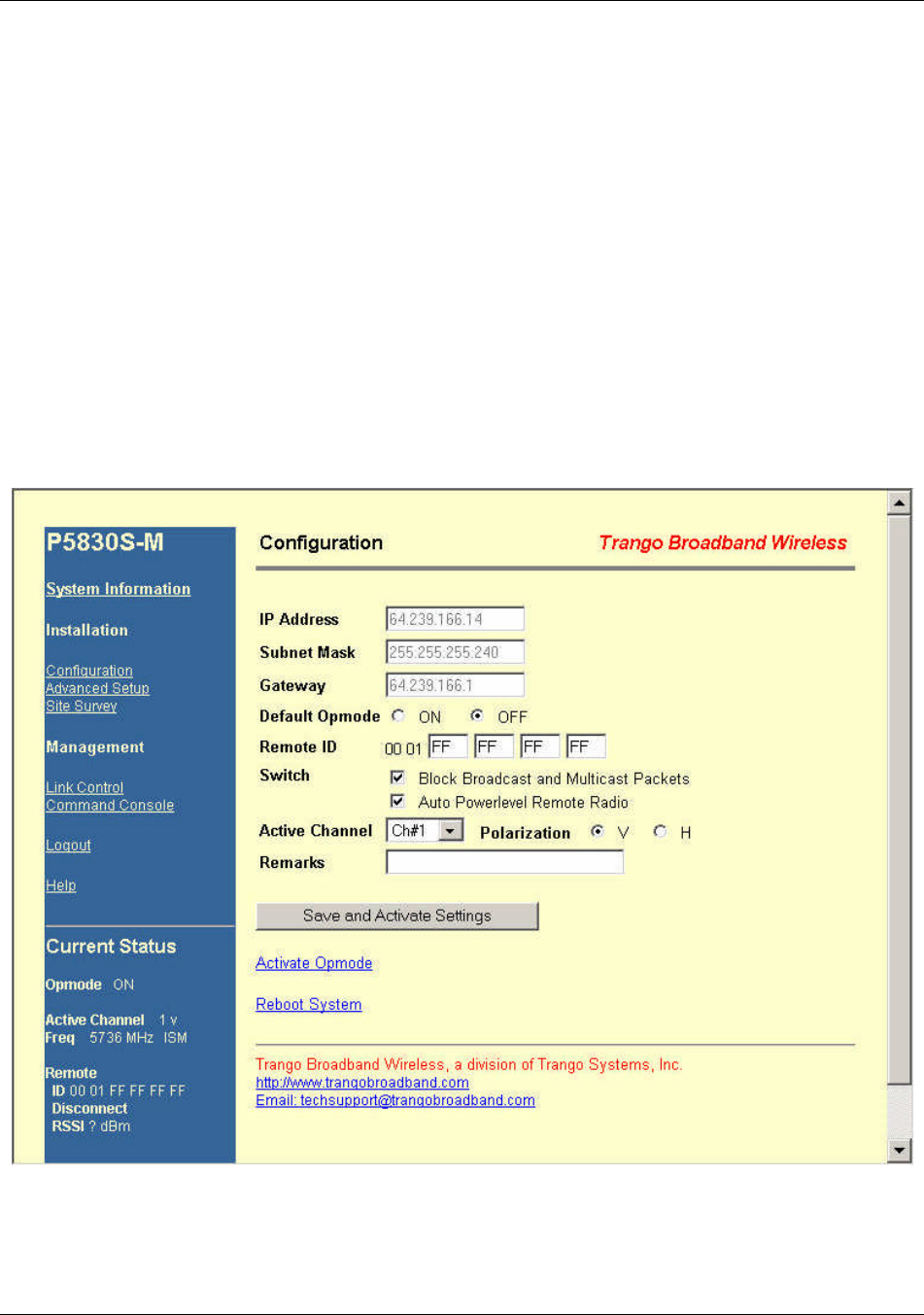
Command Set Summary Procedure to Establish Wireless Link
Trango Broadband Wireless — User Manual TrangoLINK Rev. A for F/W Ver. 1.0 Page 10
Chapter 3 Establishing a Wireless Link
This section describes how to establish a wireless link between MU and RU, using the command line interface.
Procedure to Establish Wireless Link
In order to establish a wireless link, the following parameters must be set.
1. The Remote ID, the MAC ID of the RU, must be set in the MU.
2. The MU’s RF Channel and Polarization must exist in the RU’s channel scan table.
3. The Opmode of the MU is on.
4. The Opmode of the RU is on.
5. Adequate signal strength received at each radio.
If all of these parameters are met, and if the MU and RU are within range - and properly aligned, the wireless link will
automatically establish itself and Ethernet traffic will begin to pass between the radios.
To ensure each of these parameters is met, perform the following steps:
Master Unit
Click the Configuration page link from any page in the Browser Interface.
1. Set IP, subnet, and gateway
2. Fill in the Remote ID with the MAC address of the RU
3. Set channel and polarization
4. Set default opmode to On
5. Update system setting flash memory by clicking Save and Activate Settings
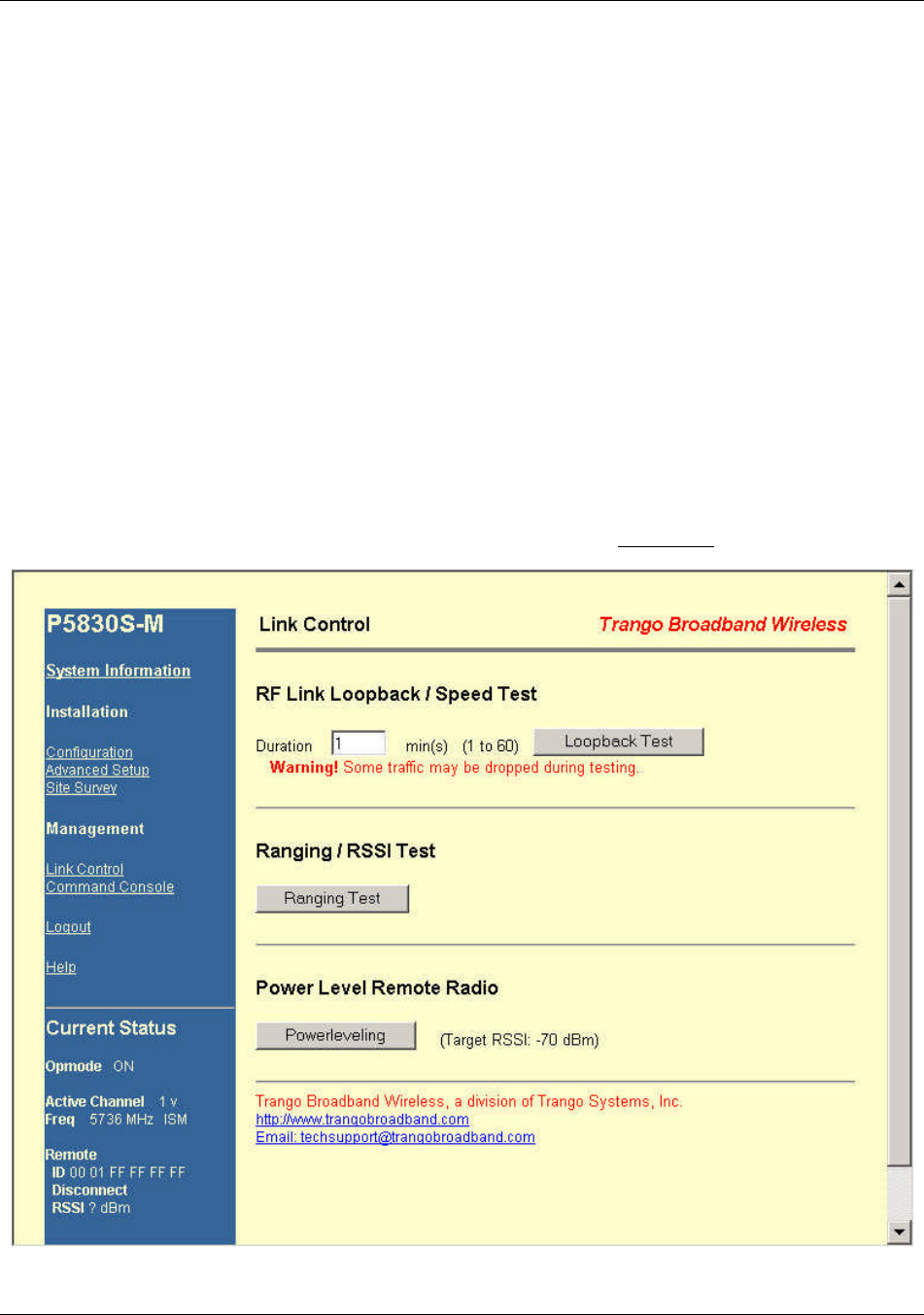
Command Set Summary Basic Diagnostics
Trango Broadband Wireless — User Manual TrangoLINK Rev. A for F/W Ver. 1.0 Page 11
At this point the MU will begin actively searching for the RU. Once the RU is detected, the authentication and
association process will begin. The RU by default is ready to establish a link. Only the RF channel and
polarization need to be chosen. By default it is on channel 1 with horizontal polarization. The default opmode is
on.
The RED LED on the bottom of the MU should be lit, indicating that the radio is in the on opmode and is radiating
RF energy.
Association Concept (MU to RU communications)
TrangoLINK uses the concept of “association” to indicate that the MUs and RUs are communicating. If all parameters
are properly set, the MU will begin actively searching for the RU. Once an active RU is detected, the authentication and
association process will begin.
? Note: The RED LED on the bottom of the MU should be lit, indicating that the radio is in opmode “MU” and is
radiating RF energy.
? Note: The amber light on the bottom of the RU indicates the relative signal strength (rssi) of the signal received. A
steady light indicates a strong signal. A blinking light indicates weaker (although perhaps sufficient) signal
strength.
Basic Diagnostics
In establishing and diagnosing the quality of the link, there several devices on the Link Control page that are especially
useful.

Command Set Summary Basic Diagnostics
Trango Broadband Wireless — User Manual TrangoLINK Rev. A for F/W Ver. 1.0 Page 12
Remote: The bottom left side of any page in the Browser Interface, under the heading Remote, shows the connection
status of the RU. It will also show the Relative Signal Strength (RSSI) of the link
RF Link Loopback Test: Sends 1600 byte packets to the RU at 50 millisecond intervals over the time specified and
reports the success rate of the packets in bytes.
Ranging/RSSI Test: Reports the distance of the link, and the RSSI from the MU to the RU.
Power Level Remote Radios: Adjusts the transmit power of the RU to attempt to bring the MU RSSI as close as
possible to the Target RSSI. Target RSSI can be adjusted on the Advanced Setup page.

Command Set Summary Site Selection
Trango Broadband Wireless — User Manual TrangoLINK Rev. A for F/W Ver. 1.0 Page 13
Chapter 4 Deployment
Once you are familiar with the basic operation of the radios you are ready for deployment in the field. The deployment
process consists of the following steps:
?? Site Selection
?? Site survey at MU and RU sites.
?? MU installation
?? RU installation and antenna alignment
?? Link test
Site Selection
Proper site selection for your MU will help ensure a successful deployment. Site selection will depend on a wide variety
of factors, but from the radio’s performance standpoint, please consider the following:
?? Path from MU to RU should provide unobstructed line-of-sight (LOS), thus it is advisable to place MU as high
as possible on a tall building or tower
?? Ethernet cable limit is 100 meters from Ethernet device (router, switch) to radio
?? Radios should never be deployed without proper grounding
?? Carefully note the antenna coverage pattern for type of MURU deployed
?? Consider nearby sources of interference which could degrade radio performance. Mount radios as far from
sources of interference as possible
Site survey
Both the MU and RU provide a powerful on-board site survey tool. This tool will tell you if there is interference present
in the 5.8 GHz or 5.3 GHz band.
In order to use the survey tool, the radio must be in opmode “OFF”. The survey can be performed for any specified
amount of time (in seconds) and for either the horizontal or vertical polarization.
Prior to performing the site survey, place the radio in the installation spot, and aim the radio in the desired direction.
After the specified period, the results of this command will provide you with a listing of each channel in the band, the
average signal received, and the maximum signal received during the survey period.
In general you will be looking for frequencies with signal strength of –85 dBm or lower. If interference is present on
various channels, it is recommended that you chose clean channels or alternate polarizations for your deployment. If it is
not possible to use a clean channel/polarization combination, there are various methods available to mitigate the affects of
interference. These methods include the use of the RFRX THRESHOLD settings, or the use of external shields on the
MU. See Example on following page:
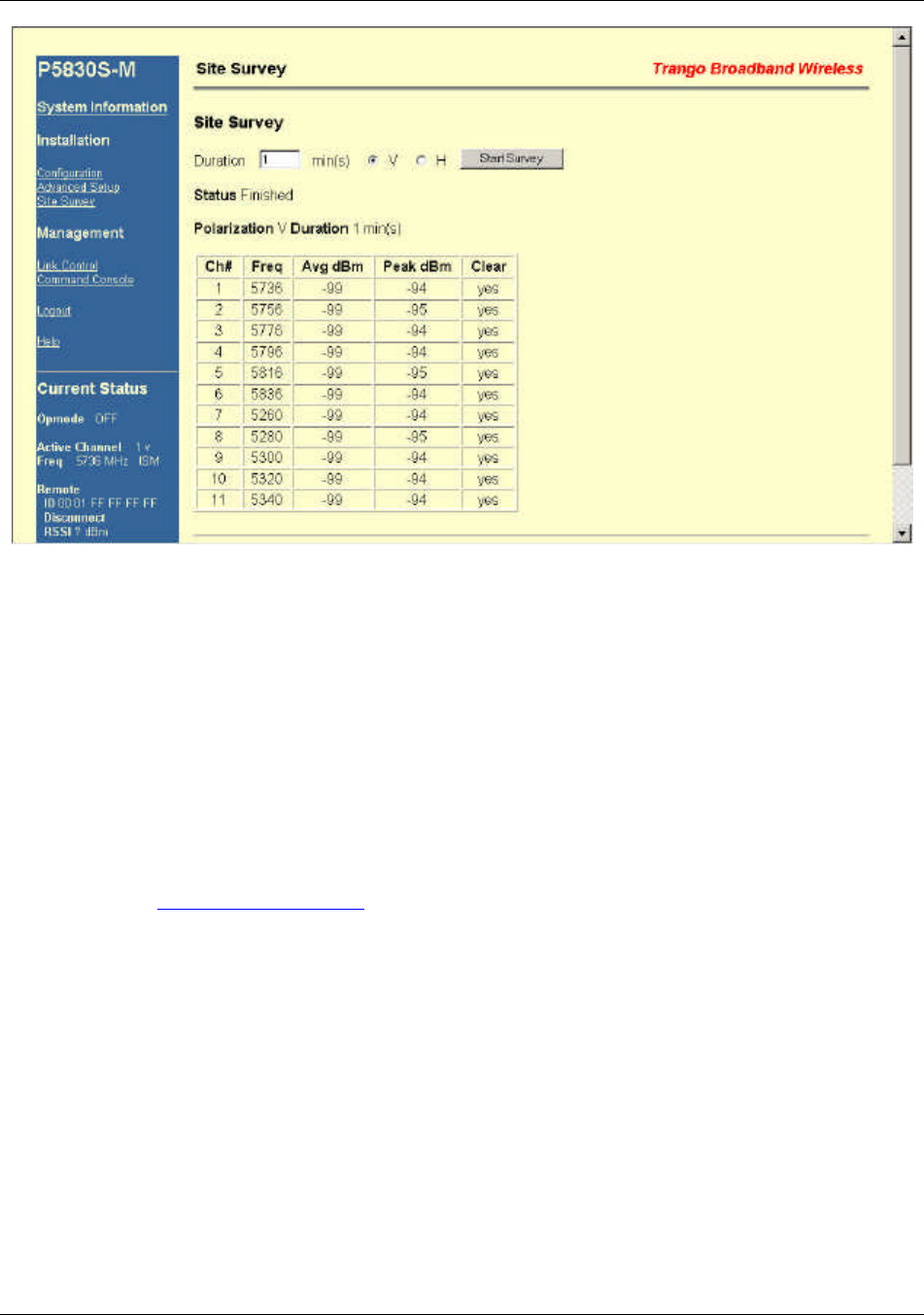
Command Set Summary Channel Planning
Trango Broadband Wireless — User Manual TrangoLINK Rev. A for F/W Ver. 1.0 Page 14
Channel Planning
For installations involving co-location of MU’s, channel planning is of paramount importance. For maximum MU co-
location quantities, it is important to assign frequencies of maximum spacing and alternating polarizations for adjacent
MUs. Use of the 5.3 spectrum U-NII band as well as the 5.8 spectrum ISM band will allow maximum co-location
potential. For very dense deployments of multiple MUs, it may be necessary to use the optional MU Shielding kit in
order to mitigate interference from nearby MUs.
Figure 0-7 Default Channel Table (MHz)
[Ch#01]5736 [Ch#02]5756 [Ch#03]5776 [Ch#04]5796 [Ch#05]5816 [Ch#06]5836
[Ch#07]5260 [Ch#08]5280 [Ch#09]5300 [Ch#10]5320 [Ch#11]5340 [Ch#12]5736
[Ch#13]5736 [Ch#14]5736 [Ch#15]5736 [Ch#16]5736 [Ch#17]5736 [Ch#18]5736
[Ch#19]5736 [Ch#20]5736 [Ch#21]5736 [Ch#22]5736 [Ch#23]5736 [Ch#24]5736
[Ch#25]5736 [Ch#26]5736 [Ch#27]5736 [Ch#28]5736 [Ch#29]5736 [Ch#30]5736
Various MU channel plans can be implemented and many of the factors will depend on the unique circumstances at each
particular site. See www.trangobroadband.com for additional information on channel planning schemes.
Installation
Once the site survey is completed, you are ready to install your radios. It is recommended that MUs be installed first.
The reason for this is that the RU has a built-in RSSI tool which will help you properly aim the RU at the MU to achieve
maximum signal strength.
Mounting Hardware
Both MUs and RUs are equipped with a universal mounting bracket which can be used for wall or pole installations. See
diagram below for proper use of the mounting bracket.
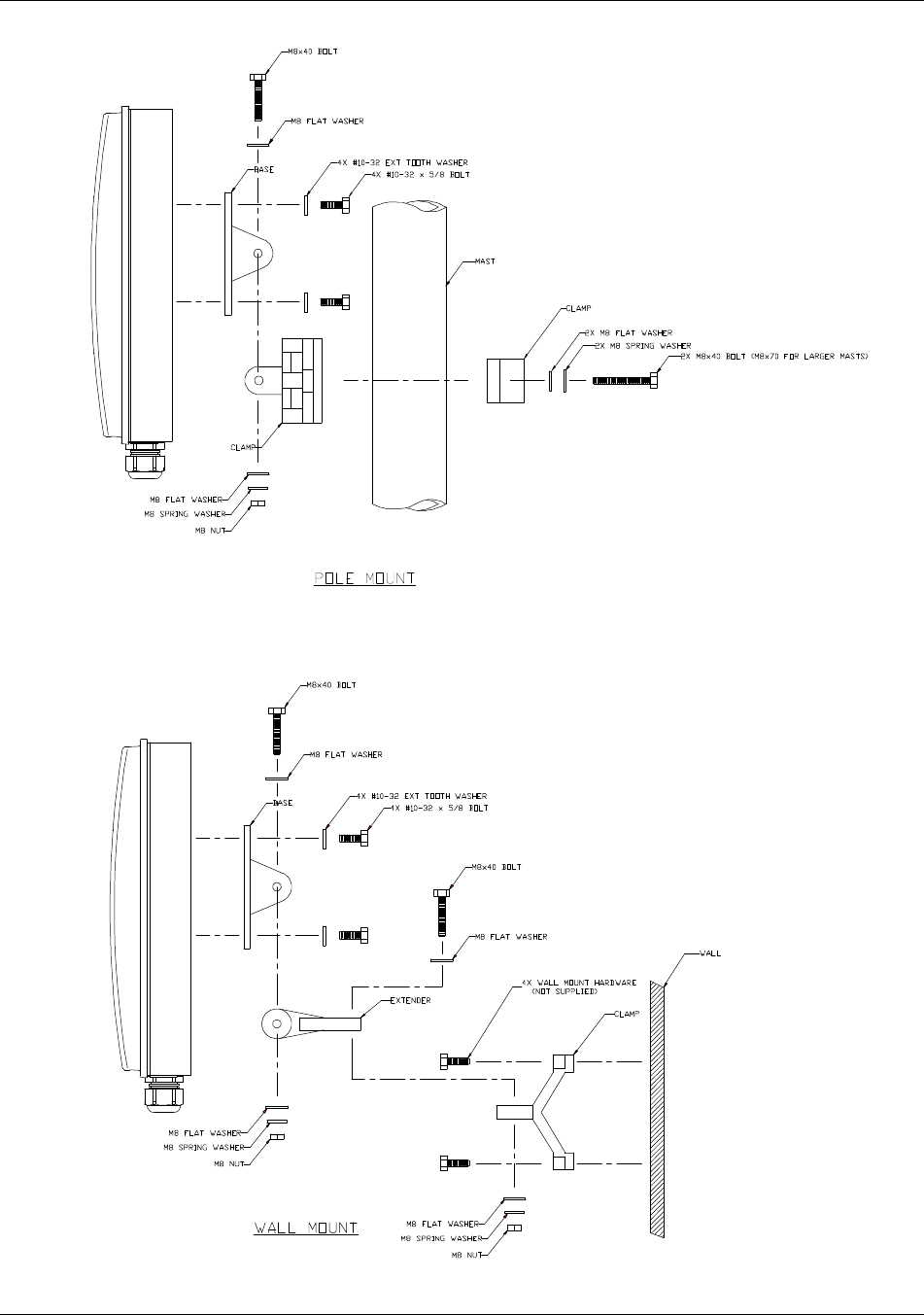
Command Set Summary Installation
Trango Broadband Wireless — User Manual TrangoLINK Rev. A for F/W Ver. 1.0 Page 15
Figure 0-8 Mounting Hardware Assembly
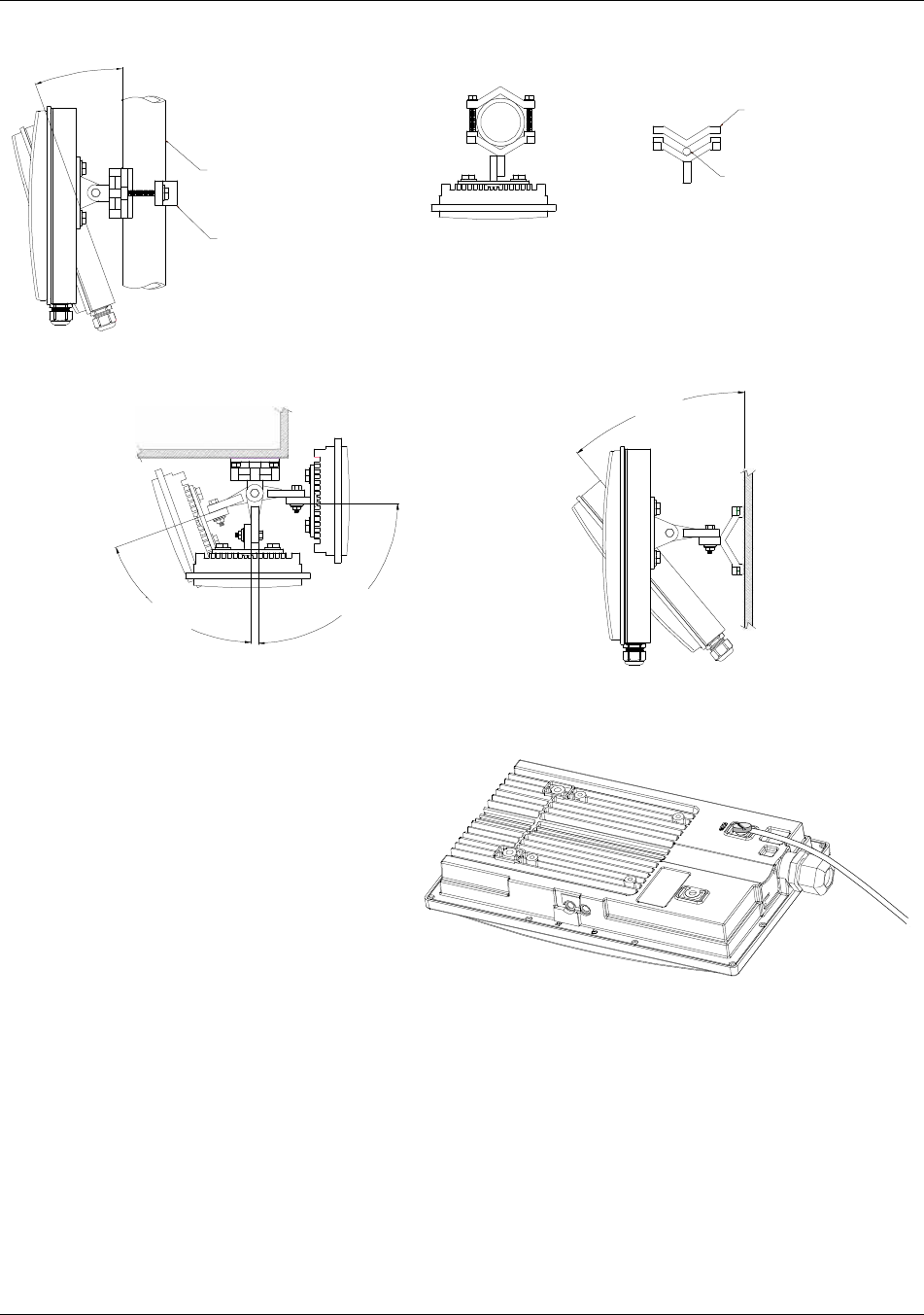
Command Set Summary Installation
Trango Broadband Wireless — User Manual TrangoLINK Rev. A for F/W Ver. 1.0 Page 16
Figure 0-9 Mounting Options
20.00
°
UP/DOWN TILT MAX
.50" - 3.00" DIAM. MAST
FOR MAST SIZES SMALLER
THAN 2.00" BRACKET MUST
BE INVERTED (SEE DETAIL 'A' BELOW)
40.00°
UP/DOWN TILT MAX
INVERTED BRACKET
SMALL DIAM. MAST
70.00° SWIVEL
IF MOUNTED NEAR
WALL
90.00° SWIVEL
IF MOUNTED ON
CORNER
POLE MOUNT
WALL MOUNT
Figure 0-10 Grounding Example
Cabling and Weather Considerations
Shielded twisted pair Cat-5 cable is recommended for all installations. The shield within the Cat-5 cable does not need to
be grounded if the radio itself is grounded. It is important to consider that most Cat-5 cable will deteriorate over time if
exposed to the weather (especially direct sunlight). It is recommended that installers place all Cat-5 cables inside conduit.
Plastic or conduit is sufficient. If metal conduit is used, it is not necessary to use shielded Cat-5 cable.
It is imperative that the radio be COMPLETELY SEALED at both the Ethernet port as well as the Serial Port
access cover. The contracting weather-proofing clamp at the bottom of the Ethernet port must be securely tightened
around the cable if conduit is not used. Proper sealing of the radio will ensure that moisture will not enter the enclosure
of the radio. Without proper sealing, moisture may enter the radio and potentially cause damage which will not be
covered under warranty.
Proper
mounting of the radio includes
consideration for grounding. Please note that if
the radio is attached to a metal pole which is
earth-
grounded, no other grounding is necessary.
If the radio is not earth-
grounded via the mounting
bracket, you must attach
a grounding wire to the
grounding stud on the back of the radio as per the
adjacent diagram.

Command Set Summary RU Installation and Antenna Alignment
Trango Broadband Wireless — User Manual TrangoLINK Rev. A for F/W Ver. 1.0 Page 17
The cable ports are purposely located at the bottom of the radio to minimize the risk of water intrusion. Do not mount
the radios upside down.
? Note: The J-Box is not a weatherized device and must be located either indoors or in a weather-protected cabinet.
? Note: It is important to provide strain relief and drip loop for STP Cat-5 cables.
RU Installation and Antenna Alignment
Once the MU is installed, and aligned in the correct general direction, it is time to install the RU. The hardware
installation of the RU is identical to the MU, including considerations for line-of-sight, cable distances, cable type,
weather sealing, and grounding.
Once the RU is installed and aimed in the general direction of the MU, it is time to perform an RSSI test to determine the
signal strength from the MU, and to precisely align the RU antenna for maximum signal strength.
RU Antenna Alignment Procedure
1. Ensure MU is in opmode “ON”
2. Connect to the RU from the Ethernet side via the Browser Interface (while in opmode “OFF”)
3. Login and observe the RSSI indicator on the bottom left of the page. As you read the RSSI reading, move the
antenna in the horizontal and vertical planes until the maximum RSSI reading is achieved. For short links you
can expect an RSSI of –60 dBm or better. For longer links and RSSI of –75 dBm is acceptable. Any RSSI of
less than –80 dBm may be too weak for the radios to reliably associate and pass data.
4. If it is not possible to receive an adequate RSSI reading, it may be necessary to reorient the MU (up/down,
left/right), to increase the output power of the MU, or to move the RU to a location with better line-of-sight
conditions to the MU.
5. Once you are satisfied with the RSSI reading, tighten down the RU in the optimum position.
? Note: The amber light on the bottom of the RU will also indicate RSSI according to the following parameters:
RSSI< -80dBm not lit
RSSI > -80dBm blinking.
RSSI ? -65dBm solid. (blink rate increases with signal strength.)
Link Test
Ensure the RU’s default opmode is “ON” and that all configuration parameters are correct.
Reboot the radio. Once the radio enters opmode “ON”, the authentication process will occur with the MU, and the two
radios will begin to associate. From the MU side, use the Link Control page to assess the quality of the link. This was
discussed earlier in the Basic Diagnostics section.
If all tests show favorable results, the wireless link will automatically begin passing Ethernet traffic between the
radios.

Command Set Summary RU Management
Trango Broadband Wireless — User Manual TrangoLINK Rev. A for F/W Ver. 1.0 Page 18
Chapter 5 Management
In the TrangoLINK system the MU controls most functions of its associated RU. For this reason it is important to consider that
you will manage your TrangoLINK system primarily through the MU.
Network management can be performed by three methods
?? Browser Interface
?? CLI Appendix – Command Set Reference
?? SNMP Manager Discussed in this section, below.
RU Management
Most management functions of the RU can be performed by issuing commands from the MU. Presented below are a few
examples of these commands:
Change the RUs IP, subnet, and gateway: re ipconfig <new ip> <new RUbnet> <new gateway>
Example: re ipconfig 192.168.10.10 255.255.255.0 192.168.10.1
A complete description of these commands and many others can be found in Appendix – Command Set Summary.
Managing MU from RU side of Network
As a security feature, TrangoLINK was designed to prevent users on the RU side of the network from accessing the MU via
telnet or HTTP interface. If it is necessary for network administrators to access a MU from the RU side of the network the user
must first telnet into a router, or similar device, located behind the MU. Then telnet from the router into the MU.
SNMP
TrangoLINK supports Simple Network Management Protocol (SNMP) for network management. Network management
consists of the following 4 categories: configuration, accounting, alarm, monitoring, and control. These capabilities allow the
network operator to provide superior services through higher network availability and integrated accounting system. For more
information on SNMP and its uses, you can visit http://www.faqs.org/faqs/snmp-faq/.
The Trango SNMP solution supports MIB-II (system only) and the Trango proprietary Management Information Base (MIB).
The SNMP agent resides on the MU ONLY. It gathers health and status, performance statistics from all RUs locally, then
responds back to the SNMP manager upon request.
Users interested in using the SNMP functionality should review the entire TrangoLINK MIB for a complete understanding of
its features.
The following is an overview of a few of the more commonly used SNMP objects in the TrangoLINK system.
Objects for Monitoring and Control
su Bandwidth Monitoring
?? suEthRxAvgThroughputLog – Average payload data throughput (in Kbits/sec) received on the Ethernet port over
the period specified by suStatisticsSamplePeriod (1 ~ 60 minutes).
?? suEthTxAvgThroughputLog - Average payload data throughput (in Kbits/sec) transmitted on the Ethernet port over
the period specified by suStatisticsSamplePeriod (1 ~ 60 minutes).
?? suRfRxAvgThroughputLog - Average payload data throughput (in Kbits/sec) received on the RF link over the
period specified by suStatisticsSamplePeriod (1 ~ 60 minutes).
?? suRfTxAvgThroughputLog - Average payload data throughput (in Kbits/sec) transmitted on the RF link over the
period specified by suStatisticsSamplePeriod (1 ~ 60 minutes).
?? suRfInOctets – Number of octets of payload transmitted from MU’s RF port.
?? suRfOutOctets – Number of octets of payload received from MU’s RF port.
MU Bandwidth Monitoring

Command Set Summary SNMP
Trango Broadband Wireless — User Manual TrangoLINK Rev. A for F/W Ver. 1.0 Page 19
?? aptrafficEthRxAvgThroughputLog – Average payload data throughput (in Kbits/sec) received on the Ethernet port
over the period of 1 minute.
?? aptrafficEthTxAvgThroughputLog – Average payload data throughput (in Kbits/sec) transmitted on the Ethernet
port over a period of 1 minute.
?? aptrafficRfRxAvgThroughputLog – Average payload data throughput (in Kbits/sec) received on the RF link over a
period of 1 minute.
?? aptrafficRfTxAvgThroughputLog – Average payload data throughput (in Kbits/sec) transmitted on the RF link over
the period of 1 minute.
?? aptrafficEthInOctets – Number of octets of payload received on the Ethernet port
?? aptrafficEthOutOctets – Number of octets of payload transmitted on the Ethernet port
?? aptrafficRfInOctets – Number of octets of payload received on the RF port
?? aptrafficRfOutOctets – Number of octets of payload transmitted on the RF port
Link Status Monitoring –Various traps are defined as follows:
?? Cold start – when SNMP agent starts running
?? Link Up – when the MU enters opmode “MU”
?? Link Down – when the MU reboots
?? SU Link Up – when su associates to the MU
?? SU Link Down – when RU disassociates from the MU
?? “MU” opmode Failure – when MU fails to enter opmode “MU”
MU and RU Control – SNMP also provides several control capabilities. The majority of the features available on the CLI are
also available via SNMP. Here are a few of these features:
?? Add/delete RUbscriber
?? Change channel
?? Set power
?? Set radio sensitivity
Review the Trango MIB (trango_P5830Sap_1p0.mib) for the complete listing of MIB Objects.
SNMP Setup
Trango Broadband provides only the MIB portion of the SNMP Management system. The radios act as individual agents, and
it is up the user to provide an SNMP Manager software from a third party vendor. Below is an example of the setup process for
SNMPc from Castle Rock™.
1. Unzip trangopkg.zip file to a local temporary directory.
2. Go to your local temporary directory, you will see 4 files shown below.
a. trango_P5830Sap_1p0.mib – M5800S AP MIB file
b. trango.ico – P5830S AP icon
c. autoico.txt – instruction file (Selects Trango icon automatically during initial set-up.)
3. Copy trango_P5830Sap_1p0.mib file to C:\Program Files\SNMPc Network Manager\mibfiles
4. Copy autoico.txt file to C:\Program Files\SNMPc Network Manager\mibfiles
5. Copy trango.ico file to C:\Program Files\SNMPc Network Manager\bitmaps
6. The MIB needs to be compiled into the SNMPc database
By default, the Read Community is set to “public”, and Write Community is set to “private” in the MU. The Trap
Community is “SNMP_trap”. The manager needs to have the same settings in order to communicate with the MU
successfully.
? Note: The Trap Community can not be set via HTTP, and CLI.
To send traps from the MU, set the following:
?? trap destination IP (Trango MIB object trapconfig–trapconfigInfo)
?? trap community string (Trango MIB object trapconfig–aptrpTable-AptrpEntry)
?? enable each trap (Trango MIB object traponfig–aptrpTable-AptrpEntry)

Command Set Summary SNMP
Trango Broadband Wireless — User Manual TrangoLINK Rev. A for F/W Ver. 1.0 Page 20
For all the set operations, set object SaveAndActivate at apsystem-apsystemInfo to write the information to
FLASH.

Command Set Summary SNMP
Trango Broadband Wireless — User Manual TrangoLINK Rev. A for F/W Ver. 1.0 Page 21
Command Set Summary
?? OFF = opmode off, ON = opmode on
?? s = serial, e = Ethernet
?? M = Master Only, R = Remote Only
?? + It may not work properly through http’s command console.
?? good for Master/Remote 1p0
Command Description OFF ON Remark
!+ redo the last command s s
? same as “help” se se
? <command> same as “help” se se
_password <new password> <new
password> specify new password (max 15 octs) se se
baud [9600 | 115200] display or set console baud rate se se default = 9600 bps
bye same as “logout”
exit same as “logout”
freq display current channel se se
freq <ch#> <h | v> change current channel and polarization se se
freq channeltable display channel table se se
freq writechannel [<ch #> <freq>]… build channel and write to flash
<ch #> = 1..30 se se
help display complete help page except “eng” se se
help <command> search and display command’s help se se
ipconfig [<new ip> <new subnet mask>
<new gateway>]+ assign radio’s ip, subnet mask and gateway ip se se
logout log out console se se
opmode [on|off] set or display current opmode se se
password specify new password (max 15 octs) s s
ping <ip address> ping local Ethernet device se se It only works for local Ethernet
devices, not SU or any device behind
SU.
power display default and current tx power level se se default = +18 dBm
power <setism|setunii>
<min|max|<dBm>>* specify tx power for both band se se SU’s power will be adjusted by AP
when association
re ipconfig <new ip> <new subnet>
assign Remote ipconfg se M

Command Set Summary SNMP
Trango Broadband Wireless — User Manual TrangoLINK Rev. A for F/W Ver. 1.0 Page 22
<new gateway>
re ping ping Remote Radio se M
re reboot reboot Remote Radio se M
re speedtest [<pkt len> <file size>] perform speedtest
<pkt len> = 64..1760 bytes
<file size> = 10..100 Mbytes
se M default:
<pkt len> = 1760 bytes
<file size> = 10 MBytes
re sysinfo request Remote’s system information se M
re testrflink [<pkt len>] perform RF loopback test testrflink
<pkt len> = 64..1760 bytes se M defaukt:
<pkt len> = 1760 bytes
reboot reboot unit se se
remarks [<str>] string length should be 1 to 28 characters se se not 31 characters
reset [all | <n1> <n2> ..] reset radio to be firmware default
n# = 0..2
Master:
0 - Channel Table, Active Channel = 1 h,
Switches and Remarks
1 - Tx Power = Max, RF Threshold = -90 dBm,
Target RSSI = -60 dBm, MIR Downstream =
10000 kbps, Upstream = 10000 kbps
2 - SNMP Community String (Read/Write) =
(public/private)
Remote:
0 - Channel Table, Active Channel = 1 h,
Switches, and Remarks
1 - Tx Power = Max, RF Threshold = -90 dBm
2 - SNMP Community String (Read/Write) =
(public/private)
se
rfrxth <ism|unii> <-90|-85|-80|-75|-70|-
65>* specify RF rx threshold se se default = -90 for both band
rfrxthreshold … same as “rfrxth”
rssi display current Rx rssi se
save same as “updateflash” se se
save mm same as “updateflash mainimage” se se
save ss same as “updateflash systemsetting” se se
set defaultopmode [on|off] set or display default opmode se se
set httpport [<port #>] set or display HTTPD port number se se default = 80
set mir [<downstream,kbps>
<upstream,kbps>] set or display MIR
<kps> = 100..10000 se se M
set rssitarget <dB> set Target RSSI threshold se se M

Command Set Summary SNMP
Trango Broadband Wireless — User Manual TrangoLINK Rev. A for F/W Ver. 1.0 Page 23
It must be in -45 to -75 and +5 dB higher than
RF Rx Threshold
set snmpcomm [<read|write>] display or assign snmp community string se se
set telnetport [<port #>] specify telnet port, <port #> = 1..65534 se se default = 23
ssrssi <ch #> <v | h> display rssi on the current channel se
survey <sec> spectrum analysis pf the entire band se
sw 0 [on | off] set sw #0 – packet filter for broadcast/multicast se se default = on
sw 1 [on | off] set sw #1 – HTTPD service se se default = on
sw 2 [on | off] set sw #2 – Auto scan Master signal se se R default = on
sysinfo display system configuration se se
temp display current temperature se se
tm display current time mark se se
uniimaxpower [<dBm>] set max tx power limit
<dBm> = -30..30 se
updateflash <mainimage | fpgaimage>
<* | <current chscksum>> <* | <new
checksum>>
get image from tftp buffer, verify checksum and
write to flash memory at main or fpga image
section.
*: skip checksum verification
se se
updateflash systemsetting write current configuration into flash memory at
system configuration section se se
ver display
1. version number and date code
2. firmware and fpga version code
3. firmware and fpga image checksum
se se

Command Set Summary SNMP
Trango Broadband Wireless — User Manual TrangoLINK Rev. A for F/W Ver. 1.0 Page 24
Chapter 6 Specifications
All specifications apply to P5830S-R and P5830S-M unless otherwise noted.
Radio Parameters High Band (ISM) Low Band (U-NII )
Frequency of Operation 5725 MHz to 5850 MHz 5250 MHz to 5350 MHz
6 non-overlapping channels 5 non-overlapping channels
Antenna Gain Internal Antenna DSS Dish 15" Patch 36" Dish
18 dBi ISM Band 24 dBi 24 dBi 30 dBi
17 dBi U-NII Band
Max Range / Fade Margin (5.8 Ghz ISM Band) 10 Miles 20 Miles 20 Miles 40 Miles
Max Range / Fade Margin (5.3 Ghz U-NII Band) 4 Miles 6 Miles 6 Miles 10 Miles
Antenna Beamwidth (azimuth) 18o 9o 9o 4o
Data Parameters
Modulation Format Direct Sequence Spread Spectrum (DSSS) with RAKE
Certification/Compliance FCC Part 15.247, 15.407 AP only: ETSI/EN301 489-1 (7.2)
Receiver Sensibility (1E10-6 BER) 1600 byte packets: -83 dBm, 64 byte packets: -87 dBm
User Data Throughput 10 Mbps
Format 10/100 BaseT 10/100 BaseT
Network Protocols All IEEE 802.3 / 802.3u compliant protocols
Configuration and Management Telnet, SNMP, TFTP, HTTP, Serial
Upstream/Downstream Throughput
Dynamic, automatically adjusts to suit demand
Physical Interfaces
Ethernet Speed (via RJ45 shielded)
10/100 BaseT, Auto-sensing
Serial Speed (via RJ11) 9600 baud
Ethernet Packet Up to 1600 byte long packets (supports VLAN/VPN pass through)
POWER PARAMETERS
Power Method Power over Ethernet (PoE). DC Voltage injected at PoE J-Box
Voltage input limits into PoE J-Box 12 VDC - 24 VDC, 20 VDC Nominal
Voltage input limits into Radio 10.5 VDC - 21 VDC
Standard Power Supply (included) 120 VAC to 20 VDC
PoE Cat-5 Max Cable length 100 meters on 24 AWG STP Cat-5 Cable
Current Draw/Power 670 mA max. (13.4 W), using 20V standard adapter
Environmental
Radio Enclosure All-weather, powder coated, cast aluminum w/polycarbonate radome
Temperature Range -40 o to 60 o C (-40 o to 140 o F)
NEMA Rating NEMA 4
Radio Dimensions 12.5 in. x 8 in. x 2 3/4 in.
Radio Weight 4 Lbs.
User Interfaces RJ45 (shielded) and RJ11

Command Set Summary SNMP
Trango Broadband Wireless — User Manual TrangoLINK Rev. A for F/W Ver. 1.0 Page 25
Chapter 7 Glossary
A
Antenna Gain The gain of an antenna is a measure of the antenna’s ability to direct or focus radio energy over a region of
space. High gain antennas have a more focused radiation pattern in a specific direction.
AP Access Point. A wireless LAN data transceiver that uses radio waves to connect a wired
network with wireless stations. It is the Point in a Point-to-Multipoint system.
AP-Centric The Access5830 is a Point to Multipoint system with the access point being the single point and Subscriber Units
being the multi-points. It is sometimes referred to as a cell system. See also Base Station.
Associated A station is configured properly to allow it to wirelessly communicate with an
Access Point.
B
Base Station
Broadcast Packet A single data message (packet) sent to all addresses on the same subnet.
C
CCK Complementary code keying. A modulation technique used by IEEE
802.11b-compliant wireless LANs for transmission at 5.5 and 11 Mbps.
Cell The area of radio range or coverage in which the wireless devices can
communicate with the base station. The size of the cell depends upon the speed
of the transmission, the type of antenna used, and the physical environment, as
well as other factors.
D
Data Rates The range of data transmission rates supported by a device. Data rates are
measured in megabits per second (Mbps).
dBi A ratio of decibels to an isotropic antenna that is commonly used to measure
antenna gain. The greater the dBi value, the higher the gain, and the more acute
the angle of coverage.
DHCP Dynamic host configuration protocol. A protocol available with many operating
systems that automatically issues IP addresses within a specified range to
devices on the network. The device retains the assigned address for a specific
administrator-defined period.
Domain Name The text name that refers to a grouping of networks or network resources based
on organization-type or geography; for example: name.com— commercial;
name.edu— educational; name.gov— government; ISPname.net— network
provider (such as an ISP); name.ar— Argentina; name.au— Australia; and so on.
DNS Domain Name Server. A server that translates text names into IP
addresses. The server maintains a database of host alphanumeric names and their
corresponding IP addresses.
DSSS Direct sequence spread spectrum. A type of spread spectrum radio transmission
that spreads its signal continuously over a wide frequency band.
E
Ethernet The most widely used wired local area network. Ethernet uses carrier sense
multiple access (CSMA) to allow computers to share a network and operates at
10, 100, or 1000 Mbps, depending on the physical layer used.
EIRP Effective Isotropic Radiated Power
F
File Server A repository for files so that a local area network can share files, mail, and
programs.
Firmware Software that is programmed on a memory chip.
G
Gateway A device that connects two otherwise incompatible networks together.
GHz Gigahertz. One billion cycles per second. A unit of measure for frequency.

Command Set Summary SNMP
Trango Broadband Wireless — User Manual TrangoLINK Rev. A for F/W Ver. 1.0 Page 26
I
IEEE Institute of Electrical and Electronic Engineers. A professional society serving
electrical engineers through its publications, conferences, and standards
development activities. The body responsible for the Ethernet 802.3 and wireless
LAN 802.11 specifications.
Infrastructure The wired Ethernet network.
IP Address The Internet Protocol (IP) address of a station, or the layer three address used in routing packets.
IP Subnet Mask The number used to identify the IP subnetwork, indicating whether the IP
address can be recognized on the LAN or if it must be reached through a
gateway. This number is expressed in a form similar to an IP address; for
example: 255.255.255.0.
ISM Industrial Scientific Medical — FCC designation for various parts of the radio spectrum oridinally allocated for
unlisenced use. For Access5830 it refers to the 5.725 to 5.850 frequency band.
Isotropic An antenna that radiates its signal 360 degrees both vertically and horizontally
in a perfect sphere.
M
MAC Media Access Control address. A unique 48-bit number used in Ethernet data
packets to identify an Ethernet device, such as an access point or your client
adapter.
Modulation Any of several techniques for combining user information with a transmitter’s
carrier signal.
Multipath The echoes created as a radio signal bounces off of physical objects.
Multicast Packet A single data message (packet) sent to multiple addresses.
O
Omni-directional This typically refers to a primarily circular antenna radiation pattern of certain antennas.
P
Packet A basic message unit for communication across a network. A packet usually includes routing
information, data, and sometimes error detection information.
R
Range A linear measure of the distance that a transmitter can send a signal.
Receiver Sensitivity A measurement of the weakest signal a receiver can receive and still correctly
translate it into data.
RF Radio frequency. A generic term for radio-based technology.
S
Spread Spectrum A radio transmission technology that spreads the user information over a much
wider bandwidth than otherwise required in order to gain benefits such as
improved interference tolerance and unlicensed operation.
T
Transmit Power The power level the radio transmits from its antenna port.
U
UNII Unlicensed National Information Infrastructure— regulations for UNII devices
operating in the 5.15 to 5.35 GHz and 5.725 to 5.825 GHz frequency bands.
UNII-1 Regulations for UNII devices operating in the 5.15 to 5.25 GHz frequency band.
UNII-2 Regulations for UNII devices operating in the 5.25 to 5.35 GHz frequency band.
UNII-3 Regulations for UNII devices operating in the 5.725 to 5.825 GHz frequency
band.
Unicast Packet A single data message (packet) sent to a specific IP address.
W
Workstation A computing device with an installed client adapte